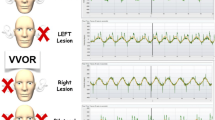Abstract
Oculomotor responses to combined optokinetic and vestibular stimulations in labyrinthine and cerebellar defective patients are discussed in terms of parametric changes in a model describing the interaction between the vestibulo-ocular reflex (VOR) and the optokinetic reflex (OKR). By making a few reasonable hypotheses about model parameter variations in relation to the type of pathology, the experimental results obtained by several authors can correctly be predicted and explained by the model. The model can therefore be used to define a set of parameters giving an estimate of the state of the system subserving VOR-OKR interaction in the examined patients. The model is also shown to be a powerful tool to assess the validity and the diagnostic significance of the procedures used to test VOR-OKR interaction.
Similar content being viewed by others
References
Baloh, R.W., Jenkins, H.A., Honrubia, V., Yee, R.D., Lau, C.G.Y.: Visual-vestibular interactions and cerebellar atrophy. Neurology 29, 116–119 (1979)
Baloh, R.W., Yee, R.D., Kimm, J., Honrubia, V.: Vestibularocular reflex in patients with lesions involving the vestibulocerebellum. Exp. Neurol. 72, 141–152 (1981)
Barnes, G.R., Benson, A.J., Prior, A.R.J.: Visual-vestibular interaction in the control of eye movement. Aviat. Space Environ. Med. 49, 557–564 (1978)
Buizza, A., Schmid, R.: Visual-vestibular interaction in the control of eye movement: mathematical modelling and computer simulation. Biol. Cybern. 43, 209–223 (1982)
Buizza, A., Avanzini, P., Schmid, R.: Visual-vestibular interaction during angular and linear acceleration: modelling and simulation. In: Mathematical and Computational Methods in Physiology Fedina, L., Kanyàr, B., Kocsis, B., Kollai, M. (eds.). Oxford: Pergamon Press 1981, pp. 13–19
Dichgans, J.: Optokinetic nystagmus as dependent on the retinal periphery via the vestibular nuclei. In: Control of Gaze by Brain Stem Neurons, Baker, R., Berthoz, A. (eds.). Amsterdam: Elsevier/North-Holland 1977, pp. 261–267
Jenkins, H.A., Honrubia, V., Baloh, R.W.: Modification of optokinetic nystagmus by horizontal semicircular canal stimulation in normal humans and patients with cerebellar degeneration. Trans. Am. Acad. Ophthal. Otolaryngol. 84, ORL 400–404 (1977)
Keller, E.L., Precht, W.: Visual-vestibular responses in vestibular neurons in intact and cerebellectomized alert cat. Neuroscience 4, 1599–1613 (1979)
Koenig, E., Allum, J.H.J., Dichgans, J.: Visual-vestibular interaction upon nystagmus slow phase velocity in man. Acta Otolaryngol. 85, 397–410 (1978)
Lisberger, S.G., Fuchs, A.F.: Role of primate flocculus during rapid behavioral modification of vestibuloocular reflex. I. Purkinje cell activity during visually guided horizontal smooth pursuit eye movements and passive head rotation. J. Neurophysiol. 41, 733–763 (1978a)
Lisberger, S.G., Fuchs, A.F.: Role of primate flocculus during rapid behavioral modification of vestibuloocular reflex. II. Mossy fiber firing patterns during horizontal head rotation and eye movement. J. Neurophysiol. 41, 764–777 (1978b)
Meiry, J.L.: Vestibular and proprioceptive stabilization of eye movements. In: The Control of Eye Movements, Bach-y-Rita, P., Collins, C.C., Hyde, J.E. (eds.). New York: Academic Press 1971, pp. 483–496
Melvill Jones, J., Milsum, J.H.: Frequency response analysis of central vestibular unit activity resulting from rotational stimulation of the semicircular canals. J. Physiol. 219, 191–215 (1971)
Miles, F.S., Fuller, J.H., Braitman, D.J., Dow, B.M.: Long term adaptive changes in primate vestibuloocular reflex. III. Electrophysiological observations in flocculus of normal monkeys. J. Neurophysiol. 43, 1437–1476 (1980)
Raphan, Th., Cohen, B., Matsuo, V.: A velocity storage mechanism responsible for optokinetic nystagmus (OKN), optokinetic afternystagmus (OKAN), and vestibular nystagmus. In: Control of Gaze by Brain Stem Neurons, Baker, R., Berthoz, A. (eds.). Amsterdam: Elsevier/North-Holland 1977, pp. 37–47
Robinson, D.A.: Oculomotor control signals. In: Basic Mechanisms of Ocular Motility and Their Clinical Implications, Lennerstrand, G., Bach-y-Rita, P. (eds.). Oxford: Pergamon Press 1975, pp. 337–374
Robinson, D.A.: Adaptive gain control of the vestibuloocular reflex by the cerebellum. J. Neurophysiol 39, 954–969 (1976)
Robinson, D.A.: Vestibular and optokinetic symbiosis: an example of explaining by modelling. In: Control of Gaze by Brain Stem Neurons, Baker, R., Berthoz, A. (eds.) Amsterdam: Elsevier/North-Holland 1977, pp. 49–58
Schmid, R., Buizza, A., Zambarbieri, D.: A non-linear model for visual-vestibular interaction during body rotation in man. Biol. Cybern. 36, 143–151 (1980)
Stefanelli, M., Mira, E., Schmid, R., Lombardi, R.: Quantification of vestibular compensation in unilateral Menière's disease. Acta Otolaryngol. 85, 411–419 (1978)
Ter Braak, J.W.E.: Untersuchungen über optokinetischen Nystagmus. Arch. Neurol. Physiol. 21, 309–376 (1936)
Waespe, W., Henn, V.: The velocity response of vestibular nucleus neurons during vestibular, visual and combined angular acceleration. Exp. Brain Res. 37, 337–347 (1979)
Waespe, W., Henn, V., Visual-vestibular interaction in the flocculus of the alert monkey. II. Purkinije cell activity. Exp. Brain Res. 43, 349–360 (1981)
Waespe, W., Henn, V., Isoviita, V.: Nystagmus slow phase velocity during vestibular, optokinetic and combined stimulations in the monkey. Arch. Psychiatr. Nervenkr. 228, 275–286 (1980)
Waespe, W., Büttner, U., Henn, V.: Visual vestibular interaction in the flocculus of the alert monkey. I. Input activity. Exp. Brain Res. 43, 337–348 (1981)
Yee, R.D., Jenkins, H.A., Baloh, R.W., Honrubia, V., Lau, C.G.Y.: Vestibular-optokinetic interaction in normal subjects and in patients with peripheral vestibular disfunction. J. Otolaryngol. 7, 310–319 (1978)
Zee, D.S., Yee, R.D., Robinson, D.A.: Optokinetic responses in labyrinthine-defective human beings. Brain Res. 113, 423–428 (1976)
Author information
Authors and Affiliations
Additional information
Work supported by CNR, Rome, Italy. Some results reported in this paper have been previously presented at the Eighth Extraordinary Meeting of the Bàràny Society, Basle, June 22th-25th, 1982.
Rights and permissions
About this article
Cite this article
Buizza, A., Schmid, R. Model interpretation of visual-vestibular interaction in patients with labyrinthine and cerebellar pathologies. Biol. Cybern. 47, 203–211 (1983). https://doi.org/10.1007/BF00337009
Received:
Issue Date:
DOI: https://doi.org/10.1007/BF00337009




